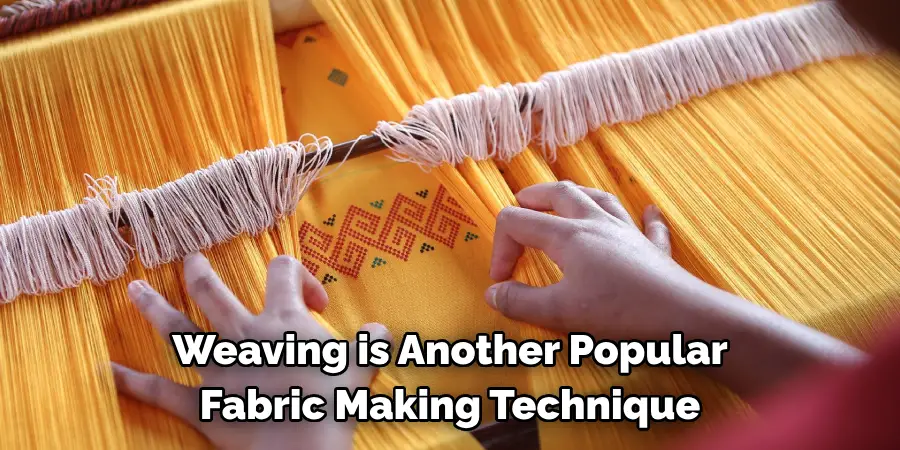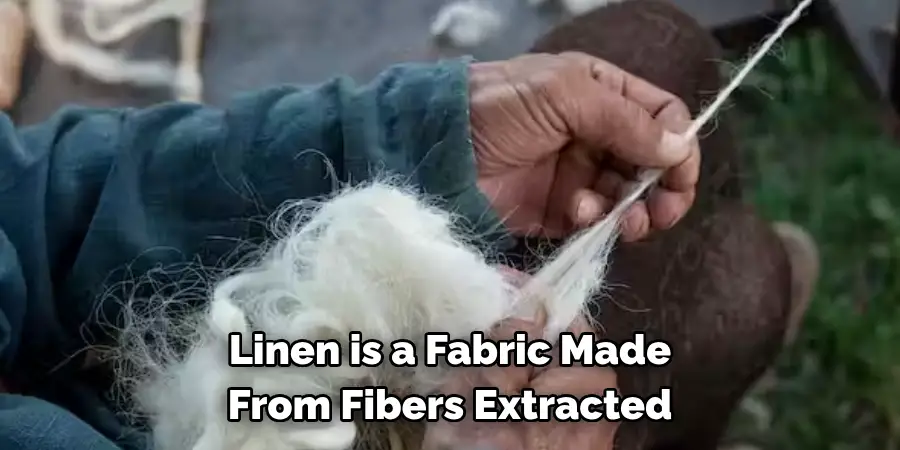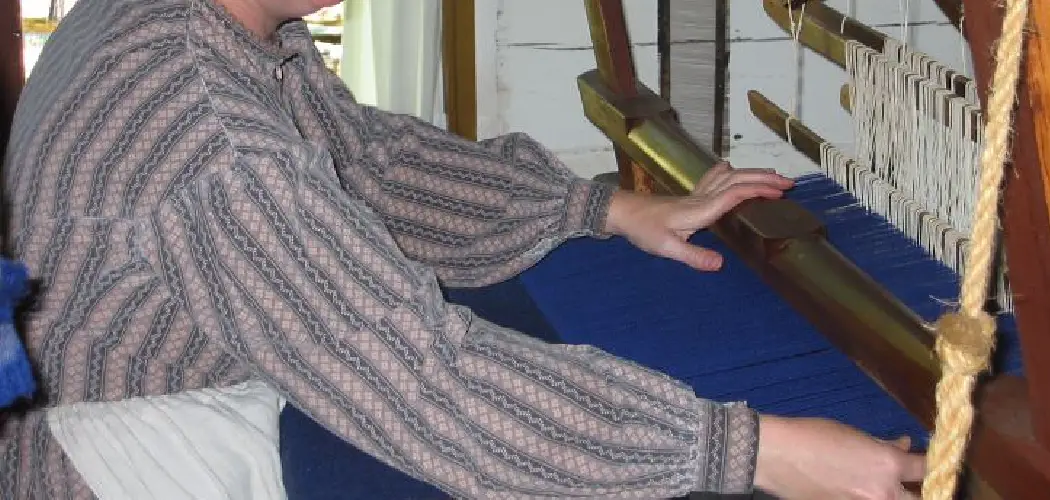If you’re someone who enjoys sewing or crafting, learning to make fabric can open up a whole new world of possibilities. Rather than relying on store-bought fabrics, you can create your own unique designs and patterns that truly reflect your personal style. In addition to the creative aspect, making fabric also allows for greater control over the quality and sustainability of your materials.

The main advantage of making fabric yourself is that you can customize it to fit your specific needs. Perhaps you want a certain type of fabric for a project but cannot find any in stores, or maybe you’re looking for an eco-friendly option. By making fabric yourself, you have the ability to choose the materials and techniques used, resulting in a unique and personalized product. You can find step-by-step instructions on how to make fabric in this blog article.
Materials You Will Need
- Cotton
- Wool
- Silk
- Linen
- Hemp
- Flax
- Synthetic fibers, such as polyester or nylon
- Dye or natural colorants
- Spinning wheel (optional)
- Loom (optional)
Fabric is a versatile and essential material used in clothing, home decor, and many other items. While it may seem daunting to create your own fabric, it is actually a relatively simple process that can be done with just a few materials.

Step by Step Processes for How to Make Fabric
Step 1: Inspect the Fiber
Before you start making fabric, it is important to inspect the fibers. Make sure they are clean and free from any debris or dirt. Next, sort the fibers according to their type and color. This step will ensure that your final fabric has a consistent look and feel.
Step 2: Clean the Fibers
To create a strong and smooth fabric, it is crucial to clean the fibers thoroughly. This will remove any impurities or oils that may hinder the bonding process. Once your fibers are clean and sorted, you can start combining them together. You can use various techniques such as spinning, twisting or weaving to create different types of fabric.
Step 3: Choose the Right Equipment
The type of fabric you want to make will determine the equipment you need. For example, if you are making a woven fabric, you will need a loom. If you are using any machinery, make sure it is clean and well-maintained before starting. This will ensure that your fabric turns out well and is free from any defects.
Step 4: Set up the loom
If you are using a loom, make sure to set it up properly according to the type of fabric you want. Adjust the tension and thread the fibers correctly. Start your weaving or stitching process carefully, making sure that each fiber is in the correct place. This will prevent any unevenness or gaps in your fabric.
Step 5: Repeat the Process
Continue weaving or stitching until you have reached your desired length of fabric. If needed, repeat the process to create multiple pieces of fabric. To prevent fraying, secure the edges of your fabric by stitching or using a serger machine. This will also give your fabric a clean and professional finish.
Step 6: Wash and Dry the Fabric
Once your fabric is complete, wash it to remove any remaining dirt or oils. Then, let it air dry or use a dryer on low heat setting. To give your fabric a smooth and crisp look, iron it on a low to medium heat setting. Make sure to use a pressing cloth if needed, to prevent any damage to the fabric.

These are the essential steps for making fabric. Remember to experiment with different types of fibers and techniques to create unique and beautiful fabrics.
Precautions for How to Make Fabric
- Whenever you are working with chemicals, it is important to protect your hands, eyes and skin. Make sure to wear gloves, safety goggles and long-sleeved clothing while making fabric.
- Many of the chemicals used in fabric-making can release toxic fumes. It is essential to have proper ventilation to avoid inhaling these fumes. Open windows, use fans or work outside if possible.
- When using chemicals, it is crucial to read the instructions carefully and follow them step by step. This will help you avoid any accidents or mistakes.
- After using chemicals, make sure to store them in designated containers according to their labels. Keep them out of reach from children and pets.
- Always keep a first aid kit handy in case of any accidents or emergencies. Make sure to have emergency contact numbers on hand as well.
- When working with tools like scissors, needles or sewing machines, exercise caution and be mindful of your movements to avoid injuries.
- It is always better to work in a clean and organized space. This will not only ensure your safety but also help you with the fabric-making process.
Making fabric can be a fun and rewarding experience, but it is important to prioritize safety. By following these precautions, you can enjoy the process of making fabric without any worries. Remember to always read instructions carefully, use proper protective gear, and work in a well-ventilated area.
What Are Some Popular Techniques Used to Make Fabric?
There are several popular techniques used to make fabric, each with their own unique characteristics and applications. In this section, we will explore some of the most common methods for making fabric.
1. Knitting
Knitting is a technique that involves the interlocking of loops of yarn or thread using needles. This method creates a stretchy and flexible fabric that can be used for various types of clothing and accessories. Knitting can be done by hand or with a knitting machine, making it accessible to both hobbyists and large-scale manufacturers.
2. Weaving
Weaving is another popular fabric-making technique that involves the interlacing of two sets of threads at right angles to create a stable and sturdy fabric. This method is commonly used for creating household items such as rugs and blankets, as well as clothing items like denim and tweed.

3. Felting
Felting is a unique technique that involves manipulating fibers together through the use of heat, moisture, and pressure to create a dense and durable fabric. This method is popular for creating woolen fabrics such as felt hats and coats.
4. Printing
Printing on fabric involves transferring an image or pattern onto the fabric using various methods such as screen printing, block printing, and digital printing. This technique allows for intricate and colorful designs to be added to fabric, making it popular for creating unique and eye-catching garments.
5. Embroidery
Embroidery is a decorative stitching technique that involves creating designs on fabric using a needle and thread or yarn. This method can be used to add intricate and personalized designs to clothing, bags, and home decor items.

6. Other Techniques
In addition to these popular techniques, there are also various other methods for making fabric such as crocheting, lace-making, macrame, and quilting. Each of these techniques has its own unique characteristics and applications that make them popular among crafters and manufacturers alike.
How Can You Fix Mistakes or Errors When Making Fabric?
Making fabric can be a fun and rewarding experience, but it’s not always perfect the first time around. Sometimes mistakes or errors can occur during the process of creating your own fabric. Here are some tips for how you can fix these issues and continue on with your fabric-making journey.
1. Identify the Mistake
The first step in fixing any issue is to identify what went wrong. Take a step back and evaluate your fabric to determine where the mistake or error occurred.
2. Try Again
If the mistake is small, you may be able to fix it by simply trying again. This can be frustrating, but it’s important not to give up and keep practicing until you get it right.
3. Make Adjustments
If the issue is more complex, you may need to make some adjustments to your fabric-making process. This could include changing the type of fabric you’re using, adjusting your stitching technique, or trying a different dyeing method.
4. Seek Help
If you’re struggling to fix the mistake on your own, don’t be afraid to seek help from others who have experience with fabric-making. Join online communities, take a class, or reach out to a friend who has successfully made fabric before. They may have valuable insights and tips that can help you fix the mistake.
5. Embrace Imperfections
Sometimes mistakes can’t be fixed completely, and that’s okay. Instead of seeing them as flaws, embrace them as part of your unique fabric creation. After all, handmade fabrics are meant to have a personal touch.
6. Learn from Your Mistakes
The most important thing to remember when fixing mistakes or errors in fabric-making is to learn from them. Take note of what went wrong and use that knowledge to improve your skills and techniques for future fabric-making projects.

How Does the Process of Making Fabric Differ for Different Types of Fabrics?
Process Overview
The general process of making fabric can be broken down into four main steps: spinning, weaving or knitting, dyeing and finishing. Spinning is the process of turning raw fibers into yarn, which is then used to create the base fabric. Weaving or knitting involves interlacing these yarns together to form a fabric structure. Dyeing adds color and patterns to the fabric, while finishing gives it its final properties such as softness, wrinkle resistance, or water repellency.
Differences in Fabric Types
Cotton, silk, wool, and linen are some of the most common types of fabric, each with its own unique properties and production methods.
1. Cotton
Cotton fabric is made from fibers extracted from cotton plants. The process involves ginning, spinning, weaving or knitting, dyeing, and finishing. Ginning removes the seeds from the cotton fibers before they undergo spinning to create yarns. The yarns are then woven or knitted together to form the fabric structure. Dyeing can be done before or after weaving/knitting, depending on the desired color and pattern. Finishing involves processes like bleaching, softening, and printing.
2. Silk
Silk is a natural protein fiber produced by silkworms, making it one of the few natural fabrics that is not plant-based. The process of making silk fabric involves sericulture, where the silkworms are grown and harvested for their cocoons, which are then unraveled to obtain the delicate filaments. These filaments are then spun into silk yarns and woven or knitted into fabric structures. Dyeing and finishing are done similarly to cotton.
3. Wool
Wool is a natural protein fiber derived from sheep. The process of making wool fabric involves shearing the sheep to obtain their fleece, which is then cleaned and carded to remove impurities and align the fibers. These fibers are spun into yarns and woven or knitted into fabric structures. Dyeing can be done at any point during the process, and finishing may involve processes like shrinking the fabric to make it more durable.
4. Linen
Linen is a fabric made from fibers extracted from the flax plant. The process involves retting, scutching, roving, spinning, weaving or knitting, dyeing and finishing. Retting is the process of breaking down the pectin in the plant stalks to loosen the fibers. Scutching removes the woody parts of the plant from the fibers, which are then combed and spun into yarns. These yarns are woven or knitted into fabric structures before being dyed and finished.

Is There a Difference in Quality Between Handmade and Store-bought Fabric?
The main difference between handmade and store-bought fabric lies in the production process. Handmade fabrics are created using traditional methods that involve skillful handwork, while store-bought fabrics are typically mass-produced using industrial machinery. As a result, handmade fabrics tend to have a higher quality and unique characteristics compared to store-bought ones.
Furthermore, handmade fabrics often use natural fibers and dyes, making them more environmentally friendly and sustainable. They also support local artisans and preserve traditional techniques. On the other hand, store-bought fabrics offer a wider variety of fabric types and designs due to their mass production methods. They are also typically more affordable than handmade fabrics.
Conclusion
In conclusion, the process of making fabric involves several steps and techniques that differ depending on the type of fabric being created. Each type of fabric has its own unique properties and production methods, with natural fabrics like cotton, silk, wool, and linen requiring different processes than synthetic ones.
Overall, understanding the process of making fabric can help us appreciate the effort and skill that goes into creating the clothes we wear every day. So next time you put on your favorite shirt or dress, take a moment to think about how it was made and the journey it took before ending up in your wardrobe. I hope this article has been beneficial for learning how to make fabric. Make Sure the precautionary measures are followed chronologically.

